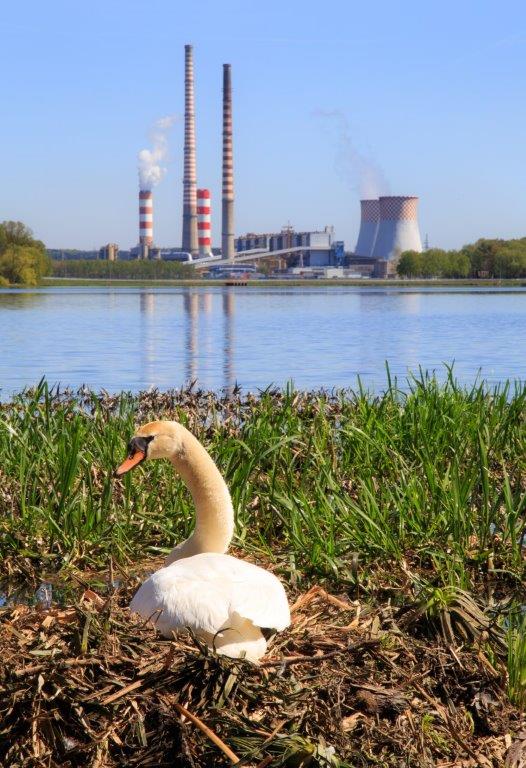PGE is aware of the finite nature of water resources and makes every effort to use them in a sustainable manner. In its operations, it uses water responsibly for the benefit of the entire ecosystem.
For the technological needs of PGE Group’s installations, water from surface water intakes is mainly used after undergoing purification processes. In order to reduce the amount of raw water consumption, closed circuits are used in the majority of cases, and used process water and wastewater are introduced to other processes. Wastewater generated by production operations undergoes treatment, including multi-stage treatment, and is then discharged to surface waters or transferred to municipal enterprises.
Depending on environmental conditions, the branches utilise appropriate water treatment and wastewater treatment technologies to ensure compliance with all environmental requirements. Adaptation to the requirements of the BAT conclusions in PGE Górnictwo i Energetyka Konwencjonalna means also the reduction of emissions to water from flue gas purification systems utilised in the process of electricity generation. In this respect, wastewater treatment plants undergo modernisation and extension processes.
In October 2020, PGE Górnictwo i Energetyka Konwencjonalna entered into a contract for the expansion of the industrial wastewater treatment system at the Turów plant. Worth over PLN 120 million, the project will be completed within 30 months from the execution of the contract. The planned industrial wastewater treatment plant will be based on modern, highly efficient membrane technologies such as microfiltration and reverse osmosis.

The efficiency of reverse osmosis is approximately 96-98%, which means that over 96% of all pollutants will be retained in the process. This will be the first such extensive application of the aforementioned technologies in the field of wastewater treatment in Poland and one of few in the European Union. Thanks to this project, the Turów plant will be the first power utility to reuse treated wastewater in its technological systems. Consequently, it will be a wastewater-free power plant. The new wastewater treatment facility will be the largest in the Polish energy sector. It will use membrane technologies with a total capacity of over 14,000 m3 per day. The implementation of this investment will have a positive impact on the border river Nysa Łużycka.
The extraction of lignite deposits based on the opencast method, carried out in the Bełchatów and Turów lignite mines, requires prior drainage of the rock mass, which has a significant impact on hydrogeological conditions and results in changes in hydrodynamic relations. Water management in lignite mines is connected with both sunk drainage and face drainage of open pits. Water from pits is discharged to field settling ponds for final purification by natural sedimentation of suspended solids supported by a plant filter or to dedicated treatment plants. Each of the opencast lignite mines operated by PGE conducts planned water protection activities. Drainage facilities used to ensure water purity are being expanded and modernised.
Drainage water at the Bełchatów mine is captured in pits and discharged through ditches to settling ponds. The concept of settling ponds is based on the technology of natural suspended solids sedimentation supported by a plant filter. Water from sunk drainage is discharged through a system of ditches and canals in quantities and with physical and chemical parameters that do not exceed the statutory limits specified in the applicable water law decision. Water discharged to surface watercourses maintains at least class II purity. In order to protect water purity in the existing natural watercourses of the region, the Bełchatów mine operates mechanical and biological wastewater treatment plants. For water protection, it is important to operate the following facilities:
In 2020, the Turów mine discharged water coming from face drainage of the pit, as well as well water and domestic wastewater into external watercourses. The quality of well water allows its direct discharge into external watercourses. Mine water and domestic wastewater were treated at five on-site wastewater treatment facilities. The branch’s mine water treatment plants are equipped with the Actiflo system. It is a highly effective process for reducing suspended solids. The volume of mine water discharge depends on the level of precipitation. In 2020, it was approximately 10 million m3. The parameters in terms of quantity and quality of discharged wastewater are determined by the requirements specified in the applicable water permits and are monitored on an ongoing basis.
PGE Energia Ciepła uses both surface and ground water to produce process water. Several plants also use water from municipal water supply systems. Depending on the size of the plant, the source and composition of raw water, different water preparation techniques are used, such as lime softening, filtration, ion exchange, ultrafiltration, reverse osmosis and electrodeionisation. In each case, the complete water preparation sequence consists of a combination of several of the above techniques.
At each stage of water preparation, particular attention is paid to its reasonable use. Many wastewater streams generated in the course of water preparation are returned to the process. Examples of this include the following:
Diagram of water circulation in electricity and heat generation processes at PGE Group
PGE Group companies that do not conduct production processes use water only for current administrative needs.